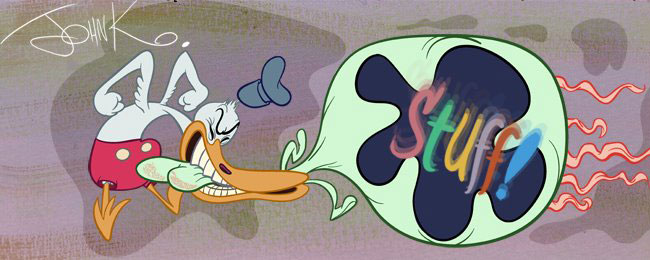 Here's a scene animated by Bob McKimson that shows the value of solid drawings. I purposely picked a scene that didn't have a lot of Clampett's direction in it. It looks like Clampett just told him what was was happening in the scene and let him do it, so it's very basic McKimson.
Here's a scene animated by Bob McKimson that shows the value of solid drawings. I purposely picked a scene that didn't have a lot of Clampett's direction in it. It looks like Clampett just told him what was was happening in the scene and let him do it, so it's very basic McKimson. Elmer tilts his head in all kinds of difficult subtle angles and he is animating slowly where you can't cheat anything.
Elmer tilts his head in all kinds of difficult subtle angles and he is animating slowly where you can't cheat anything. Elmer's body is compact and solid, yet has enough give to feel like it's flesh wrapped in cloth - note that the wrinkles in the clothes don't stick way out! The bulge just enough to feel like clothes, but bulge following the form of his body.
Elmer's body is compact and solid, yet has enough give to feel like it's flesh wrapped in cloth - note that the wrinkles in the clothes don't stick way out! The bulge just enough to feel like clothes, but bulge following the form of his body. This would be a very hard scene for an animator to do. McKimson's animation relies mostly on the drawings being solid and in perspective and moving cleanly from one pose to the next without losing volume and without have the features crawl around the face.
This would be a very hard scene for an animator to do. McKimson's animation relies mostly on the drawings being solid and in perspective and moving cleanly from one pose to the next without losing volume and without have the features crawl around the face. Titling the head into all these angles is hard enough, but that huge tall hat ads another degree of difficulty to control.
Titling the head into all these angles is hard enough, but that huge tall hat ads another degree of difficulty to control. McKimson doesn't use an overload of overlapping action (except when Bob Clampett makes him) or squash and stretch or even drag - except in fast motions. His animation is very direct and to the point. It's all in the drawing.
McKimson doesn't use an overload of overlapping action (except when Bob Clampett makes him) or squash and stretch or even drag - except in fast motions. His animation is very direct and to the point. It's all in the drawing. It doesn't always get the best inking.
It doesn't always get the best inking. The fingers are wrapped solidly around Elmer's face. His other hand around his elbow. Feet in perspective.
The fingers are wrapped solidly around Elmer's face. His other hand around his elbow. Feet in perspective. Antic into...
Antic into... Accent.
Accent. Look at those great feet!
Look at those great feet! Here's a real tricky pose to pull off. Elmer is all twisted around, laying on the ground and turned away from us. No problem for McKimson.
Here's a real tricky pose to pull off. Elmer is all twisted around, laying on the ground and turned away from us. No problem for McKimson.This scene, and WB animation is a very different approach to Disney animation, even though it uses the same fundamentals...just in a different ratio. More solidness, less accessories to distract from the main point.
Bob McKimson is the foundation of Warner Bros. animation. Most of the main animators follow McKimson's lead and that's why I think WB animation is a lot more humanized and manly than Disney's. It doesn't use a lot of animation flourishes like floppy arms and non-stop stretch and squash and overlap on everything for its own sake.
Other WB animators had their own styles, and some outright rebelled against McKimson's style, but they did it while standing on his foundation, and the most successful WB cartoons are the ones that don't get overly fancy and effeminate (Disney-esque), the ones that humans can relate to. That is a key ingredient that made WB's cartoons outlast Disney's in popularity. They still seem fresh today.

Rod Scribner in the same cartoon - a much looser approach, more cartoony and appealing, but just a personal variation of McKimson. Scribner, like McKimson and the best WB animators (unlike Disney) didn't compete with the story and voice track for attention - they were more direct in communicating with and entertaining the audience
ANIMATION SHOULD EMPHASIZE THE VOICE TRACK
A good animator will use the voicetrack as the springboard for his animation. McKimson is very literal in this approach. When the voice goes up, Elmer's head tilts up. When there is a big accented syllable, Elmer visually accents it with his head or his hands or both. His expressions match the emotion in the voice track. Watch the clip a couple times and see this in action. Close your eyes and listen to the track and listen where the accents and pauses are for emphasis, then go back and watch McKimson help draw your attention to what's already there in the soundtrack.
http://www.cartoonthrills.org/blog/Clampett/45OldGrayHare/Elmershorter2.movThe amazing thing to me is that no one followed up on this more populist approach to animation. Most animators want to emulate Disney in all its floppiness - only without the solid foundations and principles.
back later to explain more and to show some great Kahl animation...
 Here's a strong accented gesture - some nice "twins" for you. Richard Williams would approve.
Here's a strong accented gesture - some nice "twins" for you. Richard Williams would approve.
These would look even more solid if not for the DVNR and line thinning of the video transfer.

